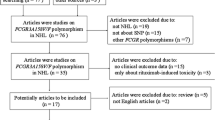Abstract
The addition of rituximab to conventional chemotherapy has significantly improved the treatment outcome in diffuse large B-cell lymphoma. However, differences in treatment response and survival data can be observed independently from the International Prognostic Index scores. The current study evaluated the impact of Fc-gamma-receptor IIIa polymorphism and gene expression profile on the response of DLBCL patients to R-CHOP therapy as well as on their survival results. Fifty-one patients were involved, thirty-two females, nineteen males, their median age was 53.1 years. The FCGR3A polymorphism at the 158. amino acid position determined with PCR method showed the following results: VV: 12 cases (23.5%), VF: 29 cases (56.8%) and FF: 10 cases (19.6%), respectively. There was no significant difference between the treatment responses of the three groups. The event-free survival data were less favorable in the F-allele carriers than in V/V homozygous patients, but without any significancy, and the overall survival curves were almost the same. As for the gene expression profile, 20 patients’ biopsy specimens showed germinal center and 31 showed non-germinal center characteristics. Treatment results did not differ from each other in the two groups. Both the event-free and the overall survival data were more favorable in the GC group, however the differences were not significant. Our results contest the predictive value of Fc-gamma-receptor IIIa polymorphism and gene expression profile in diffuse large B-cell lymphoma.



Similar content being viewed by others
Abbreviations
- ABC:
-
Activated B-cell
- ADCC:
-
Antibody dependent cellular cytotoxicity
- bp:
-
Base pair
- CD:
-
Cluster designation
- DLBCL:
-
Diffuse large B-cell lymphoma
- DNA:
-
Desoxy ribonucleic acid
- EFS:
-
Event-free survival
- F:
-
Phenylalanine
- FCGR3A:
-
Fc-gamma-receptor IIIa
- GC:
-
Germinal center
- IPI:
-
International prognostic index
- mRNA:
-
Messenger ribonucleic acid
- NK:
-
Natural killer
- OS:
-
Overall survival
- PCR:
-
Polymerase chain reactiom
- R-CHOP:
-
Rituximab, cyclophosphamide, H-daunorubicine, oncovin, prednisolone
- V:
-
Valine
References
Coiffier B, Reyes F, Groupe d’Etude des Lymphomes de l’Adulte (2005) Best treatment of agressive non-Hodgkin’s lymphoma: a French perspective. Oncology (Williston Park) 19:7–15
Nitsu N (2010) Current treatment strategy of diffuse large B-cell lymphomas. Int J Hematol 92:231–237
Sehn LH, Berry B, Chhanabhai M et al (2007) The revised International Prognostic Index is a better predictor of outcome than the standard IPI for patients with diffuse large B-cell lymphoma treated with R-CHOP. Blood 109:1857–1861
Lossos IS, Morgensztern D (2006) Prognostic biomarkers in diffuse large B-cell lymphoma. J Clin Oncol 24:995–1007
Shan D, Ledbetter JA, Press OW (1998) Apoptosis of malignant human B cells by ligation of CD20 with monoclonal antibodies. Blood 91:1644–1652
Villamor N, Montserrat E, Colomer D (2003) Mechanism of action and resistance to monoclonal antibody therapy. Sem Oncol 30:424–433
Koene HR, Kleijer M, Algra J et al (1997) FcgRIIIa-158 V/F polymorphism influences the binding of IgG by natural killer cell FcgRIIIa, idependently of the FcgRIIIa-48 L/R/H phenotype. Blood 1997:1109–1114
Hatjiharissi E, Lian X, Santos DD et al (2007) Increased natural killer cell expression of CD16, augmented binding and ADCC activity to rituximab among individuals expressing the FcgRIIIa-158 V/V and V/F polymorphism. Blood 110:2561–2564
Alizadeh AA, Eisen MB, Davis RE et al (2000) Distinct types of diffuse large B-cell lymphoma identified by gene expression profiling. Nature 403:503–511
Morgenszter D, Martin MG, Lossos IS (2007) Gene expression profiling in diffuse large B-cell lymphoma. Leuk Lymph 48:669–682
Hans CP, Weisenburger DD, Greiner TC et al (2004) Confirmation of the molecular classification of diffuse large B-cell lymphoma by immunohistochemistry using a tissue microarray. Blood 103:275–282
Cartron G, Watier H, Golay J et al (2004) From the bench to bedside: ways to improve rituximab efficacy. Blood 104:2635–2642
Cartron G, Dacheux L, Salles G et al (2002) Therapeutic activity of humanized anti-CD20 monoclonal antibody and polymorphism in IgG Fc receptor FcgRIIIa gene. Blood 99:754–758
Treon SP, Hansen M, Branagan AR et al (2005) Polymorphisms in FcgRIIIa (CD16) receptor expression are associated with clinical response to rituximab in Waldenström’s macroglobulinaemia. J Clin Oncol 23:474–481
Farag SS, Flinn IW, Modali R et al (2004) Fc gamma RIIIa and Fc gamma RIIa polymorphisms do not predict response to rituximab in B-cell chronic lymphocytic leukaemia. Blood 103:1472–1474
Carlotti E, Palumbo GA, Oldani E et al (2007) Fc gamma RIIIa and Fc gamma RIIa polymorphisms do not predict clinical outcome of follicular non-Hodgkin’s lymphoma patients treated with sequential CHOP and rituximab. Hematologica 92:1127–1130
Kim DW, Jung HD, Kim JG et al (2006) FCGR3A gene polymorphisms may correlate with response to frontline R-CHOP therapy for diffuse large B-cell lymphoma. Blood 108:2720–2725
Sjö LD, Poulsen CB, Hansen M et al (2007) Profiling of diffuse large B-cell lymphoma by immunohistochemistry: identification of prognostic subgroups. Eur J Haematol 79:501–507
Nyman H, Adde M, Karjalainen-Lindsberg ML et al (2007) Prognostic impact of immunohistochemically defined germinal center phenotype in diffuse large B-cell lymphoma patients treated with immunochemotherapy. Blood 109:4930–4935
Fu K, Weisenberger DD, Choi W et al (2008) Addition of rituximab to standard chemotherapy improves the survival of both the germinal center B-cell-like and non-germinal center B-cell-like subtypes of diffuse large B-cell lymphoma. J Clin Oncol 26:4587–4594
Mounier N, Briere J, Gisselbrecht C et al (2003) Rituximab plus CHOP (R-CHOP) overcomes bcl-2-associated resistance to chemotherapy in elderly patients with diffuse large B-cell lymphoma (DLBCL). Blood 101:4279–4284
Acknowledgment
This work was supported by the MECENATURA grant of the University of Debrecen.
Author information
Authors and Affiliations
Corresponding author
Rights and permissions
About this article
Cite this article
Váróczy, L., Zilahi, E., Gyetvai, Á. et al. Fc-Gamma-Receptor IIIa Polymorphism and Gene Expression Profile Do Not Predict the Prognosis in Diffuse Large B-cell Lymphoma Treated with R-CHOP Protocol. Pathol. Oncol. Res. 18, 43–48 (2012). https://doi.org/10.1007/s12253-011-9414-7
Received:
Accepted:
Published:
Issue Date:
DOI: https://doi.org/10.1007/s12253-011-9414-7




